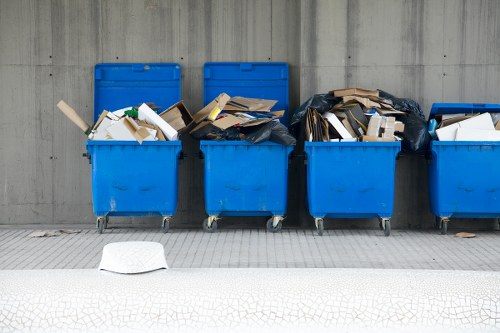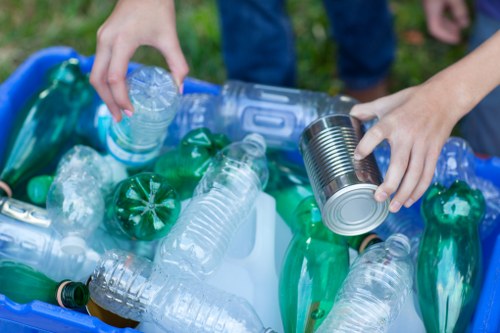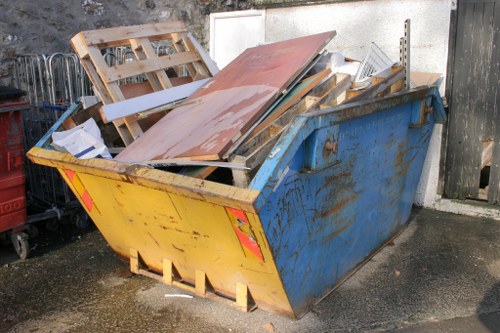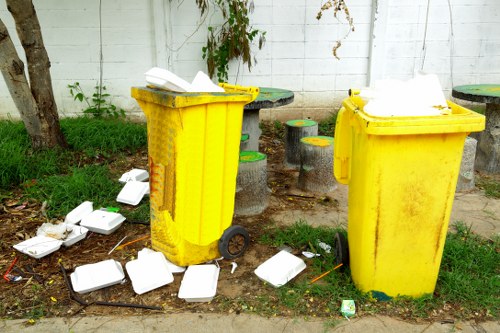Rubbish Clearance in Bills Waste

Rubbish clearance is a vital service for maintaining clean and sustainable environments. Whether you're a homeowner, a business, or part of a public sector organization, managing waste efficiently is essential. In the context of bills waste, understanding the process of rubbish clearance can help in reducing environmental impact, complying with regulations, and promoting community health.
Bills waste refers to the accumulation of non-recyclable and non-compostable materials that are disposed of by households and businesses. This type of waste can pose significant challenges if not managed properly. Effective rubbish clearance strategies not only help in minimizing landfill use but also contribute to resource conservation and environmental protection.
Implementing a robust rubbish clearance system involves several steps, including waste collection, transportation, sorting, recycling, and disposal. Each of these stages requires careful planning and execution to ensure that waste is handled responsibly and sustainably.

Understanding Bills Waste
Bills waste encompasses materials that are typically not recyclable or biodegradable. Common examples include certain plastics, electronic waste, hazardous materials, and other non-reusable items. Proper identification and categorization of bills waste are crucial for effective clearance and disposal.
Identifying bills waste involves assessing the types of materials generated and determining their appropriate disposal methods. This process helps in segregating waste at the source, which simplifies the clearance process and enhances recycling efforts.
Proper management of bills waste reduces the strain on landfill sites, curtails pollution, and supports the circular economy by promoting the reuse and repurposing of materials.

Rubbish Clearance Process
1. Waste Collection
The first step in rubbish clearance is the collection of waste from various sources. Regular collection schedules and reliable services ensure that waste is removed promptly, preventing accumulation and associated health hazards.
Residential Waste Collection
For households, separating bills waste from recyclable and compostable materials is essential. Utilizing designated bins for different waste types facilitates efficient collection and processing.
Commercial Waste Collection
Businesses generate a considerable amount of waste, including bills waste. Implementing waste management plans tailored to the specific needs of the business ensures effective clearance and compliance with local regulations.

2. Waste Transportation
Once collected, waste needs to be transported to disposal or recycling facilities. Efficient transportation logistics minimize environmental impact and reduce operational costs.
- Optimized routes for waste collection vehicles to reduce fuel consumption.
- Use of eco-friendly vehicles to lower carbon emissions.
- Timely transportation to prevent waste from lingering in the community.
Effective transportation strategies are integral to the overall rubbish clearance process, ensuring that waste is managed responsibly from collection to disposal.

3. Waste Sorting and Recycling
After transportation, waste is sorted to separate recyclable and non-recyclable materials. Recycling helps in reducing the amount of bills waste sent to landfills and promotes resource conservation.
Sorting Facilities
Advanced sorting facilities use technology to efficiently categorize waste, improving the accuracy and speed of the recycling process. This technology includes automated sorting lines, magnetic separators, and optical scanners.
Recycling Benefits
Recycling bills waste conserves natural resources, reduces greenhouse gas emissions, and supports sustainable development. It also creates job opportunities in the recycling industry, contributing to economic growth.

Environmental Impact of Bills Waste Clearance
Proper clearance of bills waste significantly impacts environmental sustainability. It minimizes the ecological footprint of waste management practices and fosters a cleaner, healthier environment.
By reducing the volume of waste directed to landfills, rubbish clearance operations contribute to less land degradation, lower greenhouse gas emissions, and decreased pollution levels in soil and water bodies.
Moreover, effective waste management initiatives enhance community well-being by reducing exposure to harmful waste materials and promoting a pristine living environment.

Regulatory Framework and Compliance
Rubbish clearance in bills waste operates within a regulatory framework designed to ensure responsible waste management. Compliance with local, state, and national regulations is mandatory for waste management companies and organizations.
Key regulatory aspects include waste disposal permits, environmental protection standards, and reporting requirements. Adhering to these regulations not only avoids legal repercussions but also promotes best practices in waste management.
Staying informed about regulatory changes and implementing necessary adjustments to rubbish clearance processes ensures ongoing compliance and sustainable operations.

Innovative Solutions in Rubbish Clearance
Advancements in technology and innovative approaches are revolutionizing rubbish clearance, making it more efficient and environmentally friendly. These innovations address the challenges posed by bills waste and enhance overall waste management practices.
Smart Waste Management Systems
Integrating smart technology into waste management allows for real-time monitoring, data analysis, and optimized operations. Smart bins equipped with sensors can indicate fill levels, enabling timely collection and reducing unnecessary trips.
Automation and AI
Artificial Intelligence and automation streamline sorting processes, increasing the accuracy and speed of recycling operations. Automated systems reduce the reliance on manual labor and minimize human error in waste categorization.
Waste-to-Energy Technologies
Converting bills waste into energy through techniques like incineration and anaerobic digestion provides a sustainable solution for waste disposal. These technologies harness the energy potential of waste, contributing to renewable energy sources.

Community Involvement and Education
Engaging the community in rubbish clearance efforts is essential for the success of waste management initiatives. Public education and participation foster a collective responsibility towards reducing bills waste and promoting sustainable practices.
Educational campaigns inform residents and businesses about proper waste segregation, recycling techniques, and the environmental impact of bills waste. This knowledge empowers individuals to make informed decisions about their waste disposal habits.
Community-based programs and partnerships with local organizations enhance the reach and effectiveness of rubbish clearance efforts, creating a unified approach to waste management.

Benefits of Community Engagement
- Increased recycling rates
- Reduced bills waste generation
- Enhanced public awareness of environmental issues
- Stronger community bonds through collective action
Active community participation leads to more efficient waste management systems and fosters a culture of sustainability.

Challenges in Rubbish Clearance
Despite advancements, rubbish clearance in bills waste faces several challenges that hinder effective waste management. Identifying and addressing these challenges are crucial for improving waste clearance operations.
Some of the primary challenges include inadequate infrastructure, insufficient funding, and limited public awareness. These obstacles can lead to inefficient waste collection, increased environmental pollution, and higher operational costs.
Addressing these challenges requires coordinated efforts between government bodies, waste management companies, and the community to develop sustainable solutions and invest in necessary resources.

Inadequate Infrastructure
Limited access to modern waste management facilities impedes the effective clearance and processing of bills waste. Investing in infrastructure such as recycling centers, waste sorting plants, and transportation vehicles is essential for enhancing waste management capabilities.
Funding and Investment
Securing sufficient funding for waste management projects ensures the implementation of advanced technologies and the expansion of waste management services. Public and private sector investments play a pivotal role in building robust rubbish clearance systems.
Public Awareness and Education
Raising awareness about the importance of proper waste management and the detrimental effects of bills waste motivates individuals to adopt responsible disposal habits. Educational initiatives can significantly influence public behavior towards waste generation and reduction.

Future Trends in Rubbish Clearance
The future of rubbish clearance in bills waste is geared towards sustainability, efficiency, and innovation. Emerging trends reflect the growing emphasis on reducing environmental impact and enhancing resource utilization.
Zero Waste Initiatives
Zero waste strategies aim to eliminate waste by redesigning resource management systems. These initiatives focus on reducing, reusing, and recycling materials to achieve minimal or no waste generation.
Circular Economy Models
Embracing a circular economy involves designing products and systems that maximize resource efficiency and extend product lifespans. This model minimizes waste and encourages the continual use of resources through recycling and repurposing.
Advanced Recycling Technologies
Advancements in recycling technologies, such as chemical recycling and biotechnological processes, enhance the ability to process bills waste more effectively. These technologies improve the quality and range of materials that can be recycled, supporting more comprehensive waste management solutions.

Green Certifications and Standards
Obtaining green certifications ensures that waste management practices meet specific environmental standards. These certifications promote accountability and encourage the adoption of best practices in rubbish clearance.
ISO 14001
ISO 14001 is an international standard that specifies requirements for an effective environmental management system. Compliance with this standard demonstrates a commitment to reducing environmental impact and improving waste management processes.
Sustainable Waste Management Policies
Developing and implementing sustainable waste management policies guide organizations in adopting environmentally responsible practices. These policies support the long-term goals of reducing bills waste and enhancing resource conservation.

Economic Benefits of Effective Rubbish Clearance
Effective rubbish clearance in bills waste not only benefits the environment but also offers substantial economic advantages. Efficient waste management practices can lead to cost savings, job creation, and economic growth.
Reducing the volume of waste sent to landfills minimizes disposal costs for municipalities and businesses. Additionally, recycling and repurposing materials create new revenue streams and reduce the need for raw material extraction.
Moreover, investing in waste management infrastructure and technologies stimulates economic activity by creating jobs in collection, transportation, processing, and recycling sectors. These employment opportunities contribute to local economies and support sustainable development.

Health and Safety Considerations
Proper rubbish clearance in bills waste is essential for safeguarding public health and ensuring workplace safety. Mismanaged waste can lead to health hazards, such as the spread of diseases, pollution, and accidents during waste handling.
Implementing stringent health and safety protocols in waste management operations reduces the risk of accidents and exposure to harmful substances. This includes providing adequate training for waste handlers, using protective equipment, and following standardized procedures for waste disposal.
Ensuring health and safety in rubbish clearance operations not only protects workers but also enhances community health by preventing environmental contamination and promoting a cleaner living environment.

Regulatory Compliance for Health Standards
Compliance with health and safety regulations is paramount in rubbish clearance operations. Adhering to guidelines set by health authorities ensures that waste management practices do not pose risks to public health.
Waste Handling Protocols
Establishing and following proper waste handling protocols minimizes the risk of contamination and exposure to hazardous materials. This includes secure storage, safe transportation, and hygienic disposal methods.
Worker Training and Protection
Providing comprehensive training for workers involved in rubbish clearance equips them with the knowledge and skills to handle waste safely. Additionally, supplying appropriate personal protective equipment (PPE) ensures that workers are protected from potential hazards.

Technology Integration in Rubbish Clearance
Integrating advanced technologies into rubbish clearance processes enhances efficiency, accuracy, and sustainability. Technological innovations address the complexities of managing bills waste and optimize the overall waste management system.
Automated Sorting Systems
Automated sorting systems utilize technologies like robotics and AI to identify and separate different types of waste materials. These systems increase sorting efficiency, reduce labor costs, and improve the accuracy of waste categorization.
Benefits of Automation
Automation in rubbish clearance leads to faster processing times, reduced human error, and consistent quality in waste sorting. It also allows for the handling of larger volumes of waste, meeting the demands of growing populations and increased waste generation.
AI and Machine Learning
Artificial Intelligence and machine learning algorithms analyze waste composition and optimize sorting processes. These technologies enable predictive maintenance, operational efficiency, and data-driven decision-making in waste management operations.

Blockchain for Waste Tracking
Blockchain technology offers a secure and transparent method for tracking waste from generation to disposal. Implementing blockchain in rubbish clearance ensures accountability, traceability, and compliance with environmental regulations.
Enhanced Transparency
Blockchain provides an immutable ledger of waste transactions, ensuring that all stakeholders have access to accurate and real-time information about waste handling processes. This transparency fosters trust and accountability in waste management operations.
Reducing Fraud and Theft
By recording every step of the waste management journey, blockchain helps prevent fraudulent activities and theft in the waste disposal process. This protection ensures that waste is handled responsibly and reaches the intended disposal or recycling facilities.

Sustainable Practices in Rubbish Clearance
Adopting sustainable practices in rubbish clearance is essential for ensuring long-term environmental health and resource conservation. Sustainable waste management strategies focus on minimizing waste generation and maximizing resource recovery.
Key sustainable practices include waste reduction, recycling, composting, and energy recovery. Implementing these practices reduces the reliance on landfills and promotes the efficient use of resources.
Furthermore, promoting sustainability in rubbish clearance operations aligns with global environmental goals, such as reducing carbon emissions and combating climate change.

Waste Reduction Strategies
Implementing waste reduction strategies involves minimizing the amount of waste generated at the source. This can be achieved through measures such as encouraging the use of reusable products, reducing packaging materials, and promoting responsible consumption habits.
Source Segregation
By segregating waste at the source, different types of waste can be managed more effectively. This segregation makes it easier to recycle and process waste, reducing the overall volume of bills waste.
Corporate Responsibility
Businesses play a crucial role in waste reduction by adopting sustainable practices, such as minimizing packaging, using eco-friendly materials, and implementing efficient inventory management systems. These actions contribute to a significant decrease in bills waste generation.

Composting and Organic Waste Management
While bills waste primarily comprises non-recyclable materials, integrating composting practices for organic waste can significantly reduce the overall waste burden. Composting transforms organic waste into valuable resources, such as fertilizer, reducing the dependency on chemical alternatives and enhancing soil health.
Benefits of Composting
Composting decreases the volume of waste sent to landfills, lowers greenhouse gas emissions, and enriches soil fertility. It also provides an eco-friendly alternative to synthetic fertilizers, supporting sustainable agriculture.
Community Composting Programs
Implementing community-based composting programs encourages local participation in waste management. These programs educate residents about the benefits of composting and provide the necessary infrastructure for effective organic waste processing.

Energy Recovery from Waste
Energy recovery technologies convert non-recyclable waste into usable energy forms, such as electricity and heat. This approach not only reduces bills waste but also contributes to the energy supply, promoting sustainability.
Incineration
Incineration involves burning waste at high temperatures to produce energy. Modern incineration facilities are equipped with advanced emission control systems to minimize environmental impact while generating renewable energy.
Anaerobic Digestion
Anaerobic digestion breaks down organic waste in the absence of oxygen, producing biogas that can be used for energy generation. This process is particularly effective for managing organic components of waste and reducing landfill reliance.

Case Studies and Success Stories
Examining successful rubbish clearance initiatives provides valuable insights into effective waste management practices. These case studies highlight best practices, innovative solutions, and the positive impacts of efficient rubbish clearance in bills waste.
One notable example is the city of San Francisco, which has implemented comprehensive waste management programs aimed at achieving zero waste. Through rigorous recycling, composting, and waste reduction initiatives, San Francisco has significantly reduced its bills waste and set a benchmark for other cities to follow.
Another success story is the implementation of waste-to-energy plants in Sweden. These facilities convert non-recyclable waste into energy, effectively reducing bills waste and contributing to the country's renewable energy goals.

San Francisco's Zero Waste Program
San Francisco's Zero Waste by 2020 initiative focuses on diverting 100% of waste from landfills through aggressive recycling, composting, and waste reduction measures. The city's efforts include mandatory recycling laws, public education campaigns, and incentives for businesses to adopt sustainable practices.
Impact of the Program
As a result of these initiatives, San Francisco has achieved remarkable reductions in bills waste, increased recycling rates, and created a more sustainable urban environment. The program serves as a model for other municipalities striving for similar environmental goals.
Lessons Learned
The success of San Francisco's program underscores the importance of comprehensive planning, community engagement, and persistent policy enforcement in achieving effective rubbish clearance and waste management.

Sweden's Waste-to-Energy Success
Sweden has become a global leader in waste-to-energy (WtE) technology, effectively managing bills waste while contributing to the country's energy needs. Swedish WtE facilities incinerate non-recyclable waste to produce electricity and heat, significantly reducing the reliance on landfills.
Technological Advancements
The integration of state-of-the-art emission control systems in Swedish WtE plants ensures minimal environmental impact. These technologies capture pollutants and convert excess heat into usable energy, maximizing the efficiency of waste-to-energy conversion.
Economic and Environmental Benefits
Sweden's WtE approach not only addresses bills waste management but also supports the country's renewable energy targets. The dual benefits of waste reduction and energy production demonstrate the potential of WtE technologies in sustainable waste management.

Best Practices for Effective Rubbish Clearance
Adopting best practices in rubbish clearance ensures that waste management operations are efficient, sustainable, and compliant with regulatory standards. These practices encompass strategic planning, technology utilization, community engagement, and continuous improvement.
Key best practices include thorough waste assessment, implementing advanced sorting technologies, fostering partnerships with recycling facilities, and regularly reviewing and updating waste management protocols.
By following these best practices, organizations can enhance their rubbish clearance processes, reduce bills waste, and contribute to broader environmental sustainability goals.

Comprehensive Waste Assessment
Conducting a detailed waste assessment provides insights into the types and quantities of bills waste generated. This information is crucial for designing effective waste management strategies and allocating resources appropriately.
Data Collection and Analysis
Gathering data on waste generation patterns helps in identifying trends, peak disposal times, and areas with high waste production. Analyzing this data enables waste management teams to optimize collection schedules and improve operational efficiency.
Customized Waste Management Plans
Based on the waste assessment, tailored waste management plans can be developed to address specific challenges and leverage opportunities for waste reduction and recycling.

Implementing Advanced Sorting Technologies
Advanced sorting technologies enhance the efficiency and accuracy of waste categorization. Investing in state-of-the-art sorting equipment enables the separation of bills waste from recyclable and compostable materials, facilitating better waste management outcomes.
Automated Sorting Systems
Automated sorting systems use robotics and sensors to identify and sort different waste types. These systems increase processing speed and reduce human error, ensuring consistent and reliable waste sorting.
Integration with Recycling Facilities
Collaborating with recycling facilities ensures that sorted bills waste is directed to appropriate processing centers. This integration streamlines the waste management process and maximizes the potential for recycling and resource recovery.

Partnerships and Collaborations
Building partnerships with local governments, recycling centers, and environmental organizations fosters a collaborative approach to rubbish clearance. These collaborations enhance resource sharing, knowledge exchange, and the implementation of effective waste management practices.
Public-Private Partnerships
Public-private partnerships leverage the strengths of both sectors to improve waste management infrastructure and services. These collaborations can lead to innovative solutions and increased funding for waste management initiatives.
Community Organizations
Engaging with community organizations promotes grassroots participation in rubbish clearance efforts. These organizations play a vital role in mobilizing residents, conducting educational campaigns, and supporting local waste reduction programs.

Measuring Success in Rubbish Clearance
Measuring the effectiveness of rubbish clearance efforts is essential for continuous improvement and achieving sustainability goals. Establishing key performance indicators (KPIs) and regularly monitoring progress helps in evaluating the success of waste management strategies.
KPIs for rubbish clearance may include waste diversion rates, recycling efficiency, operational costs, and environmental impact metrics. Tracking these indicators provides valuable insights into the strengths and areas for improvement in waste management operations.
Regular assessments and reporting ensure transparency, accountability, and informed decision-making in rubbish clearance practices.

Key Performance Indicators (KPIs)
Establishing KPIs allows waste management teams to quantify their performance and identify areas needing enhancement. Common KPIs include:
- Waste Diversion Rate: The percentage of waste diverted from landfills through recycling and composting.
- Recycling Efficiency: The effectiveness of recycling processes in recovering materials.
- Operational Costs: The expenses associated with waste collection, transportation, and processing.
- Environmental Impact: Metrics related to greenhouse gas emissions, pollution levels, and resource conservation.
Monitoring these KPIs enables organizations to track their progress, set realistic goals, and implement necessary changes to improve rubbish clearance outcomes.

Continuous Improvement and Feedback
Adopting a culture of continuous improvement ensures that rubbish clearance practices evolve with changing environmental standards and technological advancements. Soliciting feedback from stakeholders and conducting regular reviews helps in identifying opportunities for enhancement.
Stakeholder Engagement
Engaging with stakeholders, including employees, residents, and business owners, provides valuable feedback on waste management practices. This input can inform the development of more effective and user-friendly rubbish clearance solutions.
Regular Audits and Assessments
Conducting regular audits and assessments of waste management operations helps in identifying inefficiencies and areas for improvement. These evaluations support the implementation of best practices and the optimization of waste management processes.

Conclusion
Rubbish clearance in bills waste is a critical component of sustainable waste management strategies. Effective management practices reduce environmental impact, promote resource conservation, and ensure compliance with regulatory standards.
By leveraging innovative technologies, engaging the community, and addressing existing challenges, waste management systems can significantly improve rubbish clearance operations.
Investing in robust rubbish clearance services not only benefits the environment but also enhances the quality of life for communities by fostering cleaner and healthier living spaces.
Contact us today to learn more about our rubbish clearance services and how we can help you manage your bills waste efficiently.